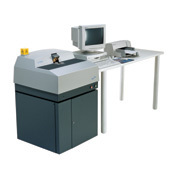Used OXFORD QX #177476 for sale
URL successfully copied!
Tap to zoom


ID: 177476
XRF X-ray Florence Spectrometer
Specifications:
10 fixed channels
Elements: Ca, Si, Al, Fe, Mg, S. Na, K, Ti, Cl
(2) computers:
ProTech Pentium computer
IBM 350-433DX computer
Software w/ discs Q181 182 183 MPAS V 4.4 DOS
View Sonic E70F 13 x 91/2" monitor
Operating manual for QX
Spare parts
220V, 50/60 Hz, 10 Amps, 1.5 KVA
1994 vintage.
OXFORD QX is a state-of-the-art Fourier transform ion cyclotron resonance (FT-ICR) spectrometer developed by OXFORD Instruments. It utilizes an ultra-high resolution mass spectrometry technique that is used to study small molecules and ions. The FT-ICR technique relies on a combination of a static magnetic field and a radio-frequency (RF) field to both isolate and characterize ions. QX consists of an 8-pole 0.7 Tesla superconducting magnet, a vacuum system, an RF system, a detector, an ion source and zero-fluid cooling system. The modified Paul trap is designed for use with small molecules and ions. The magnetic field is generated by the trapped electrons which induce a radial electrical field along the longitudinal axis of the trap. The electric field is then used to trap and isolate the ion of interest. This is achieved by controlling the frequency and intensity of the applied radio frequencies. The radio-frequency signal is generated by a signal generator and is amplified by the RF amplifier and is then applied to the trap electrodes drawing an oscillating electric field across the trap axis. This electric field deflects the ion beam of interest off the magnetic field and towards the detector. Through a gate time, ions of the same mass-to-charge ratio are selected allowing a range of ions to be detected. The detector measures ion intensity and captures the signals induced by the radio frequency field. These signals are then used to calculate the mass-to-charge ratio of the ions and the amount of current needed to fragment them. The data is then analyzed using specialized software to gain insight into fragmentation processes, ion stability and dynamics, and kinetic rate constants. OXFORD QX provides a high sensitivity for the detection of small molecules and ions and can detect ions with mass-to-charge ratios as low as 0.1 amu/q. That, coupled with its high resolution, makes QX an ideal choice for detailed structural and structural analyses of samples in the area of drug discovery and development, bioinorganic catalysis, metabolomics, proteomics, and environmental studies.
There are no reviews yet